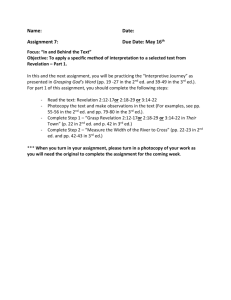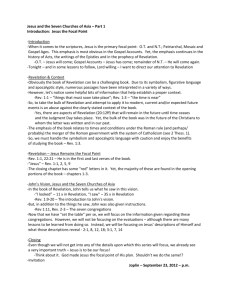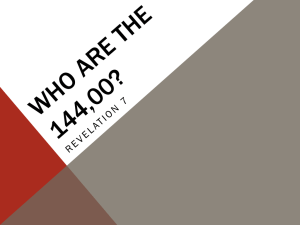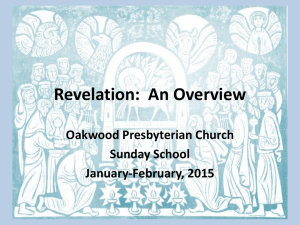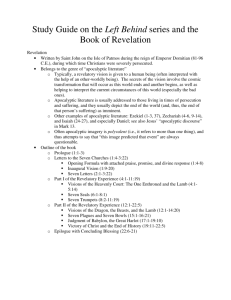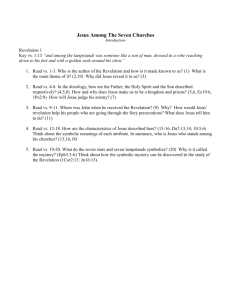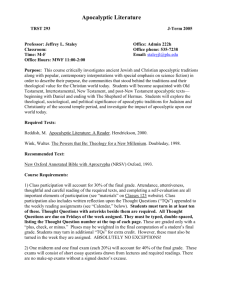Notes on Revelation
advertisement
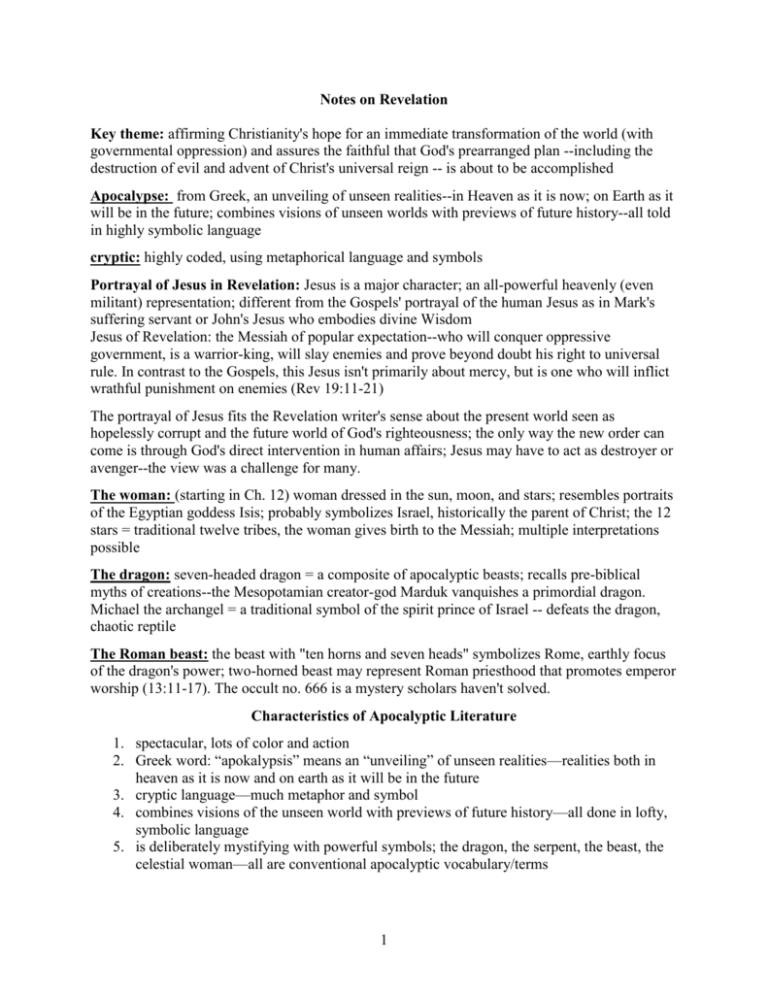
Notes on Revelation Key theme: affirming Christianity's hope for an immediate transformation of the world (with governmental oppression) and assures the faithful that God's prearranged plan --including the destruction of evil and advent of Christ's universal reign -- is about to be accomplished Apocalypse: from Greek, an unveiling of unseen realities--in Heaven as it is now; on Earth as it will be in the future; combines visions of unseen worlds with previews of future history--all told in highly symbolic language cryptic: highly coded, using metaphorical language and symbols Portrayal of Jesus in Revelation: Jesus is a major character; an all-powerful heavenly (even militant) representation; different from the Gospels' portrayal of the human Jesus as in Mark's suffering servant or John's Jesus who embodies divine Wisdom Jesus of Revelation: the Messiah of popular expectation--who will conquer oppressive government, is a warrior-king, will slay enemies and prove beyond doubt his right to universal rule. In contrast to the Gospels, this Jesus isn't primarily about mercy, but is one who will inflict wrathful punishment on enemies (Rev 19:11-21) The portrayal of Jesus fits the Revelation writer's sense about the present world seen as hopelessly corrupt and the future world of God's righteousness; the only way the new order can come is through God's direct intervention in human affairs; Jesus may have to act as destroyer or avenger--the view was a challenge for many. The woman: (starting in Ch. 12) woman dressed in the sun, moon, and stars; resembles portraits of the Egyptian goddess Isis; probably symbolizes Israel, historically the parent of Christ; the 12 stars = traditional twelve tribes, the woman gives birth to the Messiah; multiple interpretations possible The dragon: seven-headed dragon = a composite of apocalyptic beasts; recalls pre-biblical myths of creations--the Mesopotamian creator-god Marduk vanquishes a primordial dragon. Michael the archangel = a traditional symbol of the spirit prince of Israel -- defeats the dragon, chaotic reptile The Roman beast: the beast with "ten horns and seven heads" symbolizes Rome, earthly focus of the dragon's power; two-horned beast may represent Roman priesthood that promotes emperor worship (13:11-17). The occult no. 666 is a mystery scholars haven't solved. Characteristics of Apocalyptic Literature 1. spectacular, lots of color and action 2. Greek word: “apokalypsis” means an “unveiling” of unseen realities—realities both in heaven as it is now and on earth as it will be in the future 3. cryptic language—much metaphor and symbol 4. combines visions of the unseen world with previews of future history—all done in lofty, symbolic language 5. is deliberately mystifying with powerful symbols; the dragon, the serpent, the beast, the celestial woman—all are conventional apocalyptic vocabulary/terms 1 6. there is a trend of identifying the beast with a contemporary figure who is hated or feared or distrusted by the people 1. 2. 3. 4. 5. 6. Key Themes affirms Christianity’s original hope for an immediate transformation of the world— assures the faithful that God’s prearranged plan (the destruction of Evil and advent of Christ’s universal reign) is about to be accomplished places governmental oppression and Christian suffering in a cosmic perspective— conveys hope of a “new heaven and a new earth” Revelation was not the last book written, though its placement at the end of the Bible may be appropriate; Genesis is the Alpha –first letter of the Greek alphabet/ Revelation the Omega—the last letter of the Greek alphabet the first Christians believed the end was immanent; Revelation reaffirmed this same notion the sense of Jesus in Revelation is as a major figure—a messiah of expectation, a warriorking, proving the right to universal rule and coming not to bring mercy to sinners, but to inflict punishment on opponents/enemies—this perspective of Jesus is different from that of the suffering servant as Mark’s Gospel might convey or of the embodiment of wisdom as John’s gospel might convey the authors of the letter of Jude, 2nd Letter of Peter and Revelation saw their present world as hopelessly corrupt; they saw God’s intervention as the only hope for change and the future world (God planned world) as an ideal realm of purity 2

